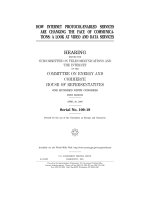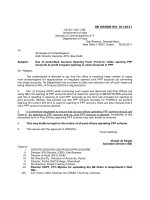Purposes of communication
Bạn đang xem bản rút gọn của tài liệu. Xem và tải ngay bản đầy đủ của tài liệu tại đây (2.04 MB, 16 trang )
Purposes of
communication
Member:
Nguyen Thu Hien
Dinh Thi Thuy Cuc
Nguyen Vu Thu phuong
Lam Thi Ngoc Dung
Pham Ngoc Quynh
Through contacts with others,
information is accumulated that
helps define who you are, where you
belong, and where your loyalties
rest.
Eg1: When you have a communication with a
PROFESSOR
Using FORMAL words, POLITE activities and behaviors
Show the RESPECTATION.
Eg2: When you talk to FRIENDS
Can use INFORMAL words.
Feel more COMFORTABLE.
Besides, communication
also helps people exchange
information.
Eg:
A: How do we have good health?
B: I think that we should do exercise
everyday.
A: I agree with you. We need to eat
healthy food, as well.
Communication assists with
person perception
Communication not only allows you to
make human connection, but it also
assists in collecting data about other
person.
Personal experience reveals that when
you meet someone for the first time,
gathering information about that
individual is necessary and begins
Eg: In a conversation, based on
communication, you can know about:
-Friendly
Humorou
s
-Strict
………
- Children
- teenager
- Adult
- Elder
…
Personalities
Job and social
position
IMFORMATION
Habits
Age
- Business man
(manager)
- Teacher
(professor)
- Student (the
third grade)
……
- Doing exercise
in the morning
- Smoking when
getting trouble
…..
That information serves 2
purposes
1.It enables you to
learn about the other
person, so you may
be better understand
the messages they
are producing.
-Doing this involves
effort from both the
sender of the
message and the
receiver.
-Through out the
information getting
from
communication,
you can understand
contend of the
messages
effectively.
2.It assists in deciding how to
present yourself to that person
When you successfully communicate your
message, you convey your thoughts and
ideas effectively.
But, when you don't, the thoughts and
ideas you are trying to impart do not
necessarily reflect your true meaning,
causing a communication breakdown and
creating roadblocks that stand in the way
of your goals – both personally and
professionally.
Conversation with others
creates an enjoyable
experiences as it produces
a feeling of warmth and
friendship.
Simple keys to make an effective
communication
Effective expressive communication can usually be
•
•
•
•
achieved by sticking to a few important guidelines:
Make sure you have the attention of the person you
wish to communicate with by establishing and
maintaining eye contact.
Try to send clear messages that are similar in both
verbal and nonverbal dimensions.
Say what you mean and mean what you say. Be
direct and honest; don't dance around the issue or
play games.
Ask for feedback to ensure the message you sent
was accurately received.
Simple keys to make an effective
communication
Effective receptive communication is based on good
•
•
•
•
•
listening skills:
Face the message sender and maintain eye contact.
Nod, smile, or occasionally make affirmative
vocalizations or other responses that tell the sender
you're paying attention.
Wait for the person to complete a thought without
interrupting to express your own ideas.
If you're not sure you understand the message, ask
questions and seek clarification.
Paraphrase what you heard so the sender can be
sure you got the right idea.
Communication allows you
to send verbal and
nonverbal messages that
can shape the behavior of
other people.
“Verbal and non-verbal communication
shapes our interactions with others in
business and interpersonal
relationships, as well as our financial
and personal success, and our physical
and psychological well-being.”
In this sense, your ability to communication
allows you to exercise a degree of control
over your environment.
• If you take a moment to reflect on the
activities of a normal day, you will discover
that you engage in innumerable situations
intended to influence others. They may
include selling products at work, asking
someone for directions when lost, soliciting a
higher grade from a professor, or rallying a
group of friends to work for a charitable
cause.
In all of these instances you are using
What is Verbal Communication?
• Verbal communication encompasses any
form of communication involving words,
spoken, written or signed.
What is Non-Verbal Communication?
• Verbal communication coexists alongside
non-verbal communication, which can
affect people’s perceptions and exchanges
in subtle but significant ways. Non-verbal
communication includes body language,
such as gestures, facial expressions, eye
contact and posture.
Why is Verbal Communication
Important?
• We use verbal communication to inform
or to impart knowledge.
• We also use it to correct a wrong.
Eg: The power of the words “I’m sorry” is
often more effective than an action.
• We can use it as a tool of persuasion. It
creates an opportunity for debate,
stimulates thought and creativity, and
deepens and creates new relationships.
Why is Non-Verbal Communication
Important?
• Four main functions of non-verbal
communication:
To express emotions
Communicate interpersonal relationships
Support verbal interaction
Reflect personality and perform rituals, such
as greetings and goodbyes.
• We can reinforce, contradict, substitute,
complement or emphasize our verbal
communication with non-verbal cues such as
gestures, expressions and vocal inflection.
How to Improve Verbal and Non-verbal
Communication
Verbal communication is enhanced when a
person is an effective listener.
• Take the time to think before you speak to
ensure that you articulate yourself clearly.
• Let other people interject and have the floor.
• Allow time for reflection on the subject at hand.
Non-verbal communication is enhanced by
watching other people’s body language, facial
expressions and intonations, and being
conscious of your own physicality and feelings.









